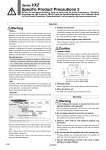Series VXZ Specific Product Precautions 2 Be sure to read before handling. Refer to back cover for Safety Instructions, “Handling Precautions for SMC Products” (M-E03-3) and the Operation Manual for 2 Port Solenoid Valves for Fluid Control Precautions. Please download it via our website, http://www.smcworld.com Selection Warning The use of a fluid that contains foreign objects can cause problems such as malfunction and seal failure by promoting wear of the valve seat and armature, and by sticking to the sliding parts of the armature etc. Install a suitable filter (strainer) immediately upstream from the valve. As a general rule, use 100 mesh. The supply water includes materials that create a hard sediment or sludge such as calcium and magnesium. Since this scale and sludge can cause the valve to malfunction, install water softening equipment, and a filter (strainer) directly upstream from the valve to remove these substances. Tap water pressure: The water pressure for tap water is normally 0.4 MPa or less. However, in places like a high-rise building, the pressure may be 1.0 MPa. When selecting tap water, be careful of the maximum operating pressure differential. When using water or heated water, poor operation or leaks may be caused by dezincification, erosion, corrosion, etc. The brass (C37) body of this product uses dezincification resistant material as a standard. We also offer a stainless steel body type with improved corrosion resistance. Please use the one that fits your needs. Generally, FKM is used as seal material, as it is resistant to oil. The resistance of the seal material may deteriorate depending on the type of oil, manufacturer or additives. Check the resistance before using. Please be aware that there is a range of pressure that can be used. Vacuum piping direction: if the system uses a vacuum pump, we ask that you install the vacuum pump on the secondary side. Also, install a filter on the primary side, and be careful that no foreign object is picked up. Please replace the valve after operating the device approximately 300,000 times. Air pressure Hydraulic pressure Low vacuum Medium vacuum High vacuum Ultra high vacuum Extreme high vacuum 102 10 1 10-1 10-2 10-3 10-4 10-5 10-6 10-7 10-8 10-9 10-1010-1110-12 Pa 109 108 107 106 105 104 103 102 101 1 10-1 10-2 10-3 10-4 10-5 10-6 10-7 10-8 10-9 10-1010-1110-12 Torr (mmHg) Drying Discharge/Plasma Neon tube/Fluorescent light Mounting 4. Ambient environment Use within the operable ambient temperature range. Check the compatibility between the product’ s composition materials and the ambient atmosphere. Be certain that the fluid used does not touch the external surface of the product. 5. Countermeasures against static electricity Take measures to prevent static electricity since some fluids can cause static electricity. Caution 1. Leakage voltage Particularly when using a resistor in parallel with a switching element and using a C-R element (surge voltage suppressor) to protect the switching element, take note that leakage current will flow through the resistor, C-R element, etc., creating a possible danger that the valve may not turn off. 2. Selecting model Material depends on fluid. Select optimal models for the fluid. 3. When the fluid is oil. The kinematic viscosity must not exceed 50 mm2/s. 1. If air leakage increases or equipment does not operate properly, stop operation. After mounting is completed, confirm that it has been done correctly by performing a suitable function test. 2. Do not apply external force to the coil section. When tightening is performed, apply a wrench or other tool to the outside of the piping connection parts. 3. Mount a valve with its coil position upward, not downward. When mounting a valve with its coil positioned downward, foreign objects in the fluid will adhere to the iron core leading to a malfunction. 4. Do not warm the coil assembly with a heat insulator etc. Use tape, heaters, etc., for freeze prevention on the piping and body only. They can cause the coil to burn out. 5. Secure with brackets, except in the case of steel piping and copper fittings. AC coil: 5% or less of rated voltage DC coil: 2% or less of rated voltage R SOL. OFF Switching element C Leakage current Leakage voltage Power supply Atmospheric pressure Warning Differential pressure Vapor deposition Surface physics Charged particle beam A 38
